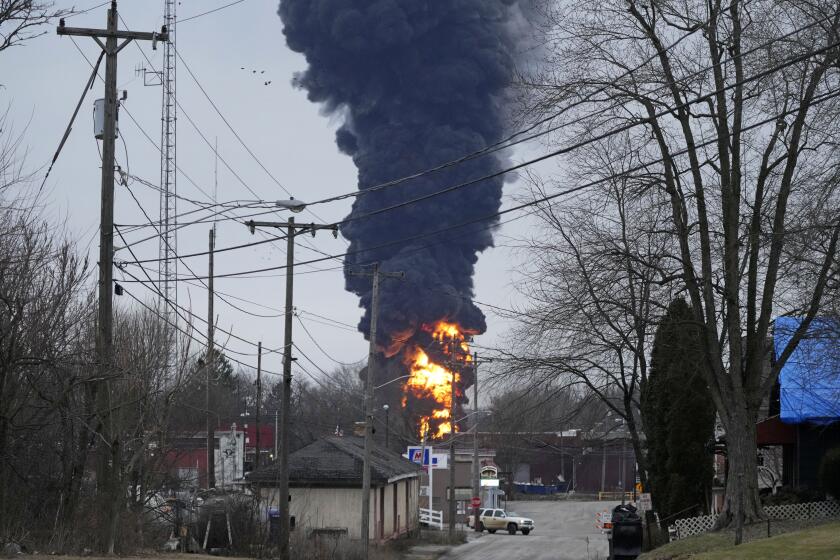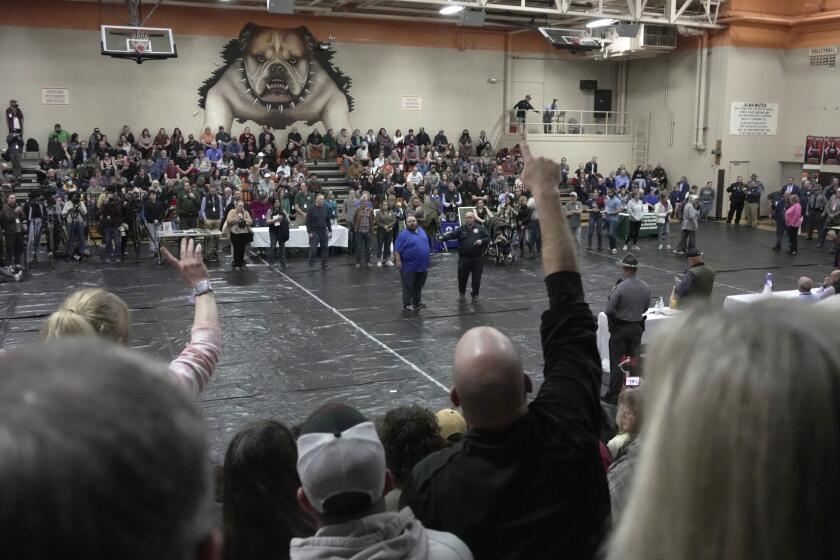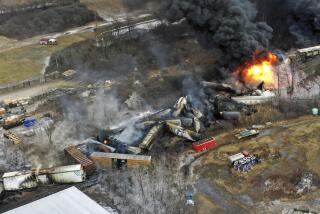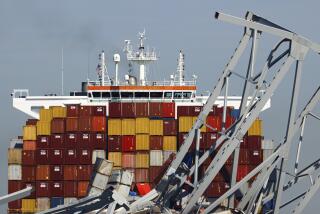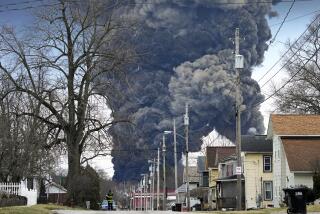Crew of train was alerted of overheated axle just before Ohio derailment, report says
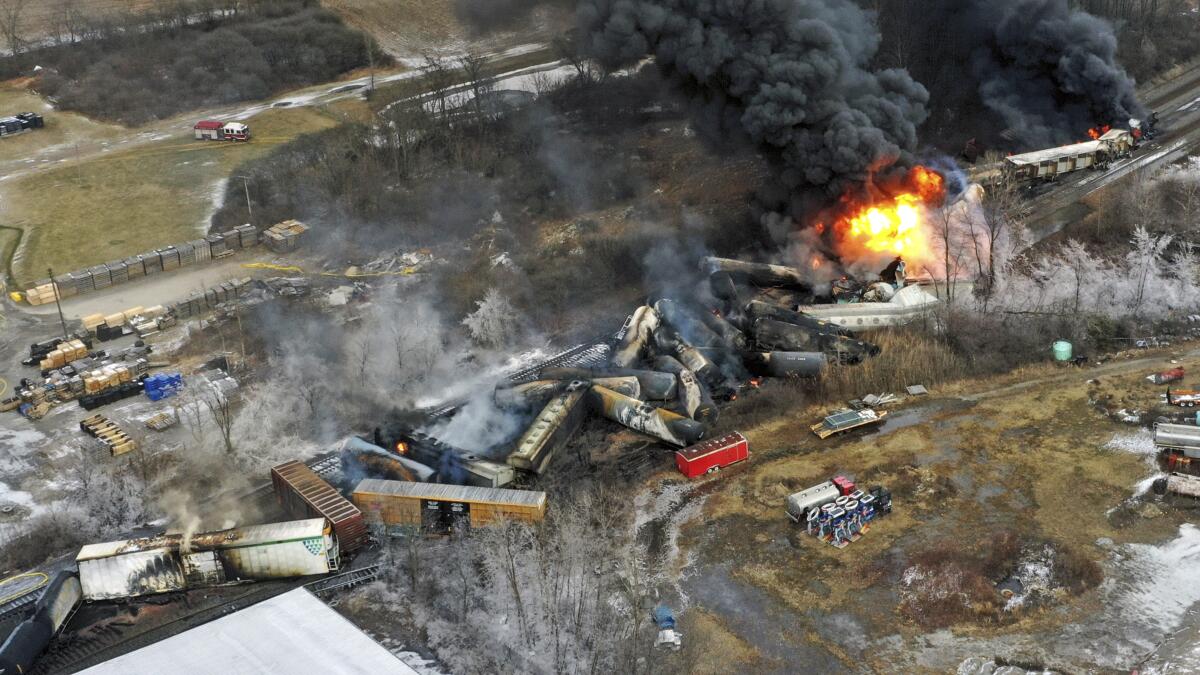
- Share via
EAST PALESTINE, Ohio — The crew operating a freight train that derailed in East Palestine, Ohio, didn’t get much warning before dozens of cars went off the tracks, and there is no indication that crew members did anything wrong, federal investigators said Thursday as they released a preliminary report into the fiery wreck that prompted a toxic chemical release and an evacuation.
U.S. Transportation Secretary Pete Buttigieg made his first visit to the crash site and took shots at former President Trump, who had visited the day before and criticized the federal response to the train derailment. Their back-and-forth was the latest sign that the East Palestine wreck has become a hot-button political issue, prompting a rebuke from the head of the National Transportation Safety Board.
“Enough with the politics. I don’t understand why this has gotten so political,” safety board Chair Jennifer Homendy, clearly exasperated, said at a briefing in Washington, D.C., on Thursday. “This is a community that is suffering. This is not about politics. This is about addressing their needs, their concerns.”
The NTSB report, which laid out the facts that investigators have gathered to date, said crew members had no indication the train was in trouble until an alarm sounded just before it went off the tracks.
An engineer slowed and stopped the train after getting a “critical audible alarm message” that signaled an overheated axle, according to the report. The three-person crew then saw fire and smoke and alerted dispatch, the report said.
“We have no evidence that the crew did anything wrong,” said Homendy, who announced a rare investigatory field hearing to be conducted in East Palestine this spring as officials seek to get to the bottom of the derailment’s cause and build consensus on how to prevent similar wrecks.
Investigators said the temperature of the failed wheel bearing increased by 215 degrees in a span of 30 miles, but did not reach the temperature threshold that railroad company Norfolk Southern had set for an alarm to go off until just before the wreck.
The train was going about 47 mph at the time, just under the speed limit of 50 mph, according to safety investigators.
Officials are asking about railroad safety after a fiery derailment in Ohio forced evacuations over concerns about the toxic chemicals on the train.
Outside experts who looked at the report said the system appeared to work as designed, from the spacing of the hot bearing detectors along the tracks to the operation of the sensors.
“There’s nothing in the NTSB report that surprises me at all,” said Dave Clarke, former director of the Center for Transportation Research at the University of Tennessee. “I can’t see anything to really criticize about what happened or how the response was made.”
Christopher Barkan, director of the Rail Transportation and Engineering Center at the University of Illinois, said the spacing of the sensors that recorded the temperatures of the Norfolk Southern train — 10 and 20 miles apart — is common in the industry.
He said the detectors would not have notified the train crew of elevated bearing temperatures unless they met the threshold for action.
“I don’t see anything wrong here, but we just don’t know,” Barkan said.
Homendy said investigators would look at whether industry safety standards — including high-temperature alarm thresholds and sensor spacing — will need to change to prevent similar derailments.
Norfolk Southern said the NTSB report showed the heat detectors worked as intended and the train crew operated “within the company’s rules.” Nevertheless, the company said it would “need to learn as much as we can from this event” and “develop practices and invest in technologies that could help prevent an incident like this in the future.”
A train derailment in Ohio, followed by the burning of hazardous chemicals, has people in the region concerned about smoke, drinking water and pets.
The freight cars that derailed on the East Palestine outskirts, near the Pennsylvania state line, included 11 carrying hazardous materials. Villagers evacuated as fears grew about a potential explosion of smoldering wreckage.
Officials seeking to avoid an uncontrolled blast intentionally released and burned toxic vinyl chloride from five rail cars, sending flames and black smoke into the sky. That left people questioning the potential health effects even as authorities maintained they were doing their best to protect people.
As the NTSB released its preliminary findings, Buttigieg — who had been criticized for not coming to East Palestine earlier — went on a tour of the crash site and defended the Biden administration’s response to the Feb. 3 derailment, which Trump had portrayed as indifferent and a “betrayal.”
Buttigieg told reporters that if the former president — and current Republican presidential candidate — felt strongly about increased rail safety efforts, “one thing he could do is express support for reversing the deregulation that happened on his watch.”
Residents of an Ohio village near where a freight train derailed want to know whether they are safe from toxic chemicals that spilled or were burned off.
White House Press Secretary Karine Jean-Pierre excoriated “political stunts that we’re seeing from the other side” but did not say whether a trip by Democratic President Biden was in the works.
Another Biden administration official, EPA Administrator Michael S. Regan, has been to East Palestine multiple times, most recently Tuesday as the EPA ordered Norfolk Southern to pay for the cleanup.
With heavy equipment rumbling behind him, Buttigieg slammed Norfolk Southern and other freight rail companies for fighting regulations he said would “hold them accountable and the other railroad companies accountable for their safety record. What we’ve seen is the industry goes to Washington and gets their way.” He pressed Congress to act.
Heather Bable, who lives two blocks from the derailment site, said she’s relieved the government’s top brass is finally showing up.
“We need that attention because we weren’t getting it. They should have been here all along,” said Bable.
After throngs of residents lined the streets in pouring rain to welcome Trump on Wednesday, the reception for Buttigieg was decidedly more muted, with little fanfare around the village of just under 5,000 residents. Trump won nearly 72% of the vote in this heavily Republican region in 2020.
Democratic U.S. Rep. Chris Deluzio, whose Pennsylvania district borders the derailment site, asked Norfolk Southern to expand the boundaries of the geographic zone in which it is providing financial assistance and testing. He asserted that the current zone excludes many affected Pennsylvania residents and businesses, and said the company should commit to cleaning up soil and water up to 30 miles beyond it.
“Norfolk Southern is failing to show any commitment to rebuilding lost trust in our community,” Deluzio wrote in a letter to the company’s president and chief executive, Alan Shaw. Providing additional resources “would help your company restore the sense of security that the Norfolk Southern train derailment and its aftermath destroyed.”
More to Read
Sign up for Essential California
The most important California stories and recommendations in your inbox every morning.
You may occasionally receive promotional content from the Los Angeles Times.

